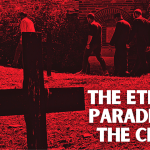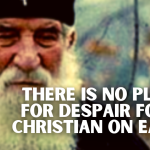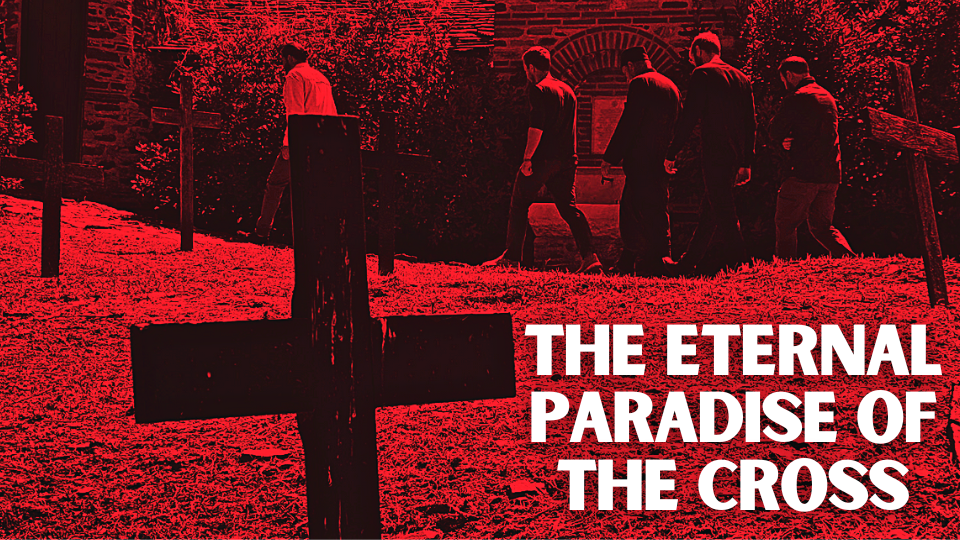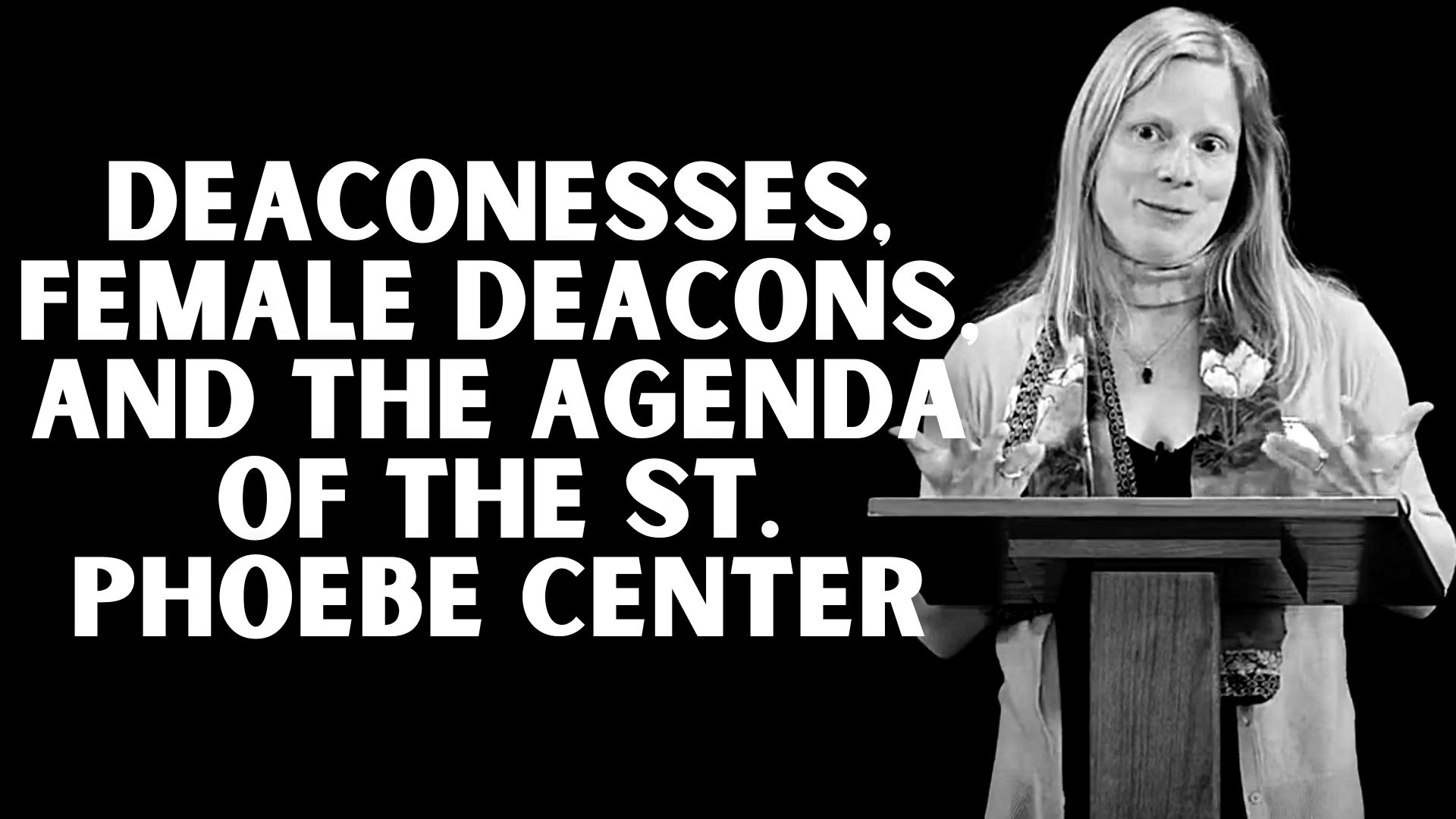Below is my translation from the Russian of the eighth sermon by New Hieromartyr Seraphim (Zvezdinski) on the Divine Liturgy. The preceding sermons may be found here. This is a continuing series.

Sermon 8
The Lord says, “I am the bread which came down from heaven” (Jn. 6:41). The bread is His Divine Body and His Pure Blood – Holy Communion, that ever strengthens, enlivens and purifies us. Holy Communion is the Sun of righteousness ever sanctifying our life. From this Sun shines forth three rays; It is the diamond set in the ark of three sections.[1]A reference to the ark of Noah. Cf. Genesis 6:16. The Divine Liturgy consists of three parts. From ancient times the Service has been subdivided in such a manner because even the first liturgy in the upper room of Zion consisted of three parts.
The Mystical Supper began first of all with the preparation. The Lord told His disciples, “Go and prepare the upper room” (cf. Lk. 22:8). After the preparation, the Lord sat at the table with His disciples (but Judas did not remain until the end of the supper, he “departed,” as the catechumens depart, not having baptism). Finally, [ …][2]Break in the original text the Lord began the sacred rite and under the forms of bread and wine, He gave the disciples to taste of His Body and Blood. And so, the Divine Liturgy consists of three parts. The first part is proskomedia, which is a Greek word because the whole Divine Liturgy came to us[3]i.e. the Russians from the Greeks. Proskomedia means “offering.”
The bread for Communion must be made from wheat and it must be leavened. The shape of the loaf must be round and made of two parts. Round wheat bread is taken in memory of that bread which the Savior used when completing the first Liturgy. The round shape reminds us of a denarius coin and indicates that we have been bought by Christ the Savior who gave Himself for us; He Himself has purchased us. The bread is called Prosphora, that is – an offering. It is called by this name in remembrance of the faithful who would bring bread to the church for the service of the holy Liturgy, much as we today bring candles, oil, and other such things (in offering). The two parts of the prosphora speak of the two natures of Christ – Human and Divine. For it is by this “denarius” that we have been purchased, such is the sacrifice that the God-Man voluntarily offered on our behalf, Himself being the Son of God and the Son of the Virgin. At the Liturgy, five prosphora loaves are used.[4]This is standard Slavic practice. Greek practice uses one loaf. “Why is this?” you may ask me. Simply look at the Cross – five loaves are offered in memory of the five wounds of our Lord Jesus Christ.
Now I will move on to an explanation of the Liturgy itself. I have already told you that it is composed of three parts. The first of which is called “Proskomedia.” It is dedicated to the commemoration of the Nativity of Christ. As Christ was born in obscurity and practically unknown until the age of thirty, when He was revealed to the world, so proskomedia is served in the altar (sanctuary) with the holy doors closed. The sufferings of Christ are also commemorated in the service of proskomedia, but as if in anticipation [ …][5]Break in the original text in a manner such as the Righteous Simeon the God-bearer foresaw them.
Before offering the Liturgy, the priest acknowledges his weakness and sinfulness, and feeling holy awe before the great service into which he is entering, he turns to the Lord in prayer seeking help. This is why before approaching the Holy Supper he stands before the (holy doors of) the iconostasis in fear; confessing his helplessness, he strengthens himself in prayer to the Lord. The priest has already been preparing himself for service since the past evening;[6]Through his prayer rule of preparation for Holy Communion now having entered the temple he must, above all else, be at peace with everyone in his mind and forgive everyone every offense. People often speak of unworthy priests, and some folks announce that because of such priests they do not come to church and do not respect clergy because some behave in an unworthy manner. O, what thoughtlessness and what religious ignorance! Are the accomplishing hands that hold forth the changed mysteries in the Chalice those of an angel or an unworthy priest?
The Lord said, “The scribes and Pharisees have seated themselves in the chair of Moses. Therefore, whatever they tell you to observe, observe and do, but do not imitate their works” (Matt. 23:2-3). The Lord spoke these words about priests who were sinful, depraved, and embittered to the core. St. John Chrysostom says a person should be thankful to God that Holy Communion is given to him by a weak priest because if the Liturgy were offered by an angel of God, he would not allow sinners to approach the holy things.
Acknowledging his weakness with fear, the priest calls upon the Lord for help. Before the holy doors, the priest prays, “O Heavenly King …” through to the “Our Father.” In recognition of his sinfulness he prays, “Have mercy on us, O Lord, have mercy on us …” Here he, as a priest, asks that his iniquities be forgiven according to the limitless mercy of the compassionate God, and he then proclaims, “We are His people.” Further, he beseeches the Most-Pure Virgin to “open the doors of compassion” because she is “the salvation of the Christian race.”[7]All quoted texts are excerpts from prayers used during the priestly entrance prayers. The full prayers may be found in most Liturgy service books.
Having said these prayers, the priest then bows to the image of the Savior that is next to the holy doors and kisses it as he prays, “Thy Most-Pure image …” And he then also bows to the image of the Mother of God and kisses it while praying, “Make us worthy of mercy, O Theotokos, fountain of tenderness …” He then proceeds to kiss all the other [primary] icons on the iconostasis while chanting their troparia. The veneration of the holy icons is offered to supplicate the aid of the Mother of God and the holy God-pleasers on behalf of the weak and sinful priest before the offering of the dread Liturgy. On the other hand, by this veneration the priest also witnesses that our Orthodox Church fulfills the decrees of the Seventh Ecumenical Council to honor holy icons.
Then the priest stands before the royal doors with his head bowed and prays, “O Lord, stretch forth Thy hand …” Again he begs for grace-filled help and still he refrains from entering into the service of the Liturgy. Yet again he asks for strength to complete the service of the Liturgy so that standing uncondemned before the awesome throne he may offer the bloodless sacrifice. This prayer as it were strengthens him and he finally resolves to enter the altar. Yet before entering the altar, he turns and asks for prayer and forgiveness from the gathered faithful, seeking support from them in his weakness.
With the words of the psalm in his mouth, “I will enter Thy house …”,[8]Psalm 5 he enters into the altar. He makes three bows before the holy Table and kisses the Gospel and cross which lay upon it, as if the Lord Himself is sitting on the His throne of glory. The priest then makes three bows towards the east and proceeds to vest. Vestments represent that the priest must lay aside everything earthly and be clothed in the grace of God. As the priest vests himself in the sticharion, he prays, “My soul shall rejoice in the Lord, for He hath clothed me with the robe of gladness; as a bridegroom He hath set a crown on me; and as a bride adorns herself with jewels, so hath He adorned me.” Then with the appropriate prayers, he vests himself in the remaining vestments. All of these prayers call upon and exalt the strengthening power of the grace of God. When fully vested, the priest then washes his hands while praying, “I will wash my hands in innocence ….”[9]Psalm 25:6-10 It should be said that in ancient times all the faithful washed their hands upon entering the church and for this purpose, a washstand stood at the entrance. St. John Chrysostom says the faithful washed their hands two times, once when entering the church and the other when exiting, as they gave alms. I myself remember, when I was a boy, before entering an old temple that our family attended, we washed our hands in a bowl according to this ancient custom.
Fully vested, the priest then approaches the table of oblation and a final time turns to God with prayer before starting proskomedia, bringing to remembrance the Redeeming Sacrifice of Christ. Offering three bows, he reads, “God cleanse me a sinner and have mercy on me,” and “By Thy precious blood Thou hast redeemed us from the curse of the law …” The priest then proclaims the blessing, “Blessed is our God, always now and ever and unto the ages of ages,” and thus he begins to offer proskomedia.
I will say more about this at another time but right now I want to remind you again, my friends, to love this diamond of God – the Divine Liturgy. Be present at the offering of the Liturgy with fear and reverence. Call to mind how I told you even the angels themselves envy[10]cf. Homily 1 that we have been given such an incalculable gift. The angels descend from the heavenly realms to be present at the offering of the Liturgy! The venerable Seraphim[11]St. Seraphim of Sarov himself witnessed this presence of the angels. The disciples of our venerable father Sergius saw how an angel served with him;[12]The disciples were Isaacius the Silent and Macarius. See The Northern Thebaid, Monastic Saints of the Russian North, St. Herman of Alaska Brotherhood. Platina, 2004. pg. 35, for the full account in … Continue reading other saints have very similar testimonies. How then could we not lay aside everything earthly so to taste of this spring of Life?
About the author
Husband, father, and Priest.
Schooling: Kharkov State University (Ukraine); Brownsville School of Ministry; St. Tikhon's Orthodox Seminary (M.Div.).
Author and illustrator of St. Patrick, Enlightener of the Irish Lands (Conciliar Press, out of print) and illustrator of The Life of St. Brigid (authored by Jane G. Meyer).
Proprietor and writer at the Inkless Pen Blog, at which, based on the foundation of the teachings of Orthodox Christianity, a wide variety of topics are addressed. Fr. Zechariah has translated some works by St. Dimitry of Rostov and New Hieromartyr Seraphim (Zvesdensky), these translations are also available on his blog.
-
Fr. Zechariah Lynchhttps://www.patristicfaith.com/author/zechariahlynch/April 7, 2024
-
Fr. Zechariah Lynchhttps://www.patristicfaith.com/author/zechariahlynch/February 29, 2024
-
Fr. Zechariah Lynchhttps://www.patristicfaith.com/author/zechariahlynch/
-
Fr. Zechariah Lynchhttps://www.patristicfaith.com/author/zechariahlynch/April 17, 2023
References[+]
| ↑1 | A reference to the ark of Noah. Cf. Genesis 6:16. |
|---|---|
| ↑2, ↑5 | Break in the original text |
| ↑3 | i.e. the Russians |
| ↑4 | This is standard Slavic practice. Greek practice uses one loaf. |
| ↑6 | Through his prayer rule of preparation for Holy Communion |
| ↑7 | All quoted texts are excerpts from prayers used during the priestly entrance prayers. The full prayers may be found in most Liturgy service books. |
| ↑8 | Psalm 5 |
| ↑9 | Psalm 25:6-10 |
| ↑10 | cf. Homily 1 |
| ↑11 | St. Seraphim of Sarov |
| ↑12 | The disciples were Isaacius the Silent and Macarius. See The Northern Thebaid, Monastic Saints of the Russian North, St. Herman of Alaska Brotherhood. Platina, 2004. pg. 35, for the full account in English. |
















